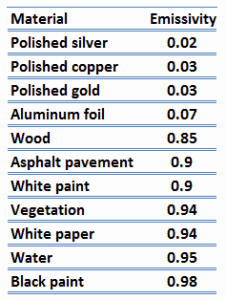Kirchhoff’s Law of thermal radiation:
For an arbitrary body emitting and absorbing thermal radiation in thermodynamic equilibrium, the emissivity is equal to the absorptivity.
emissivity ε = absorptivity α
As a result of this law, heat cannot spontaneously flow from cold system to hot system, and the second law of thermodynamics is still satisfied.
In general, both the emissivity, ε, and the absorptivity, α, of a surface depending on the temperature and the radiation wavelength. Kirchhoff’s law of thermal radiation, postulated by German physicist Gustav Robert Kirchhoff, states that a surface’s emissivity and absorptivity at a given temperature and wavelength are equal.
Kirchhoff’s Law of thermal radiation:
For an arbitrary body emitting and absorbing thermal radiation in thermodynamic equilibrium, the emissivity is equal to the absorptivity.
emissivity ε = absorptivity α
 This law must also be valid to satisfy the Second Law of Thermodynamics. As was written, all bodies above absolute zero temperature radiate some heat. Two objects radiate heat toward each other. But what if a colder object with high emissivity radiates toward a hotter object with very low emissivity? This seems to violate the Second Law of Thermodynamics, which states that heat cannot spontaneously flow from cold system to hot system without external work being performed on the system. The paradox is resolved by the fact that each body must be in direct sight of the other to receive radiation from it. Therefore, whenever the cool body is radiating heat to the hot body, the hot body must also be radiating heat to the cool body. Moreover, a hot body will radiate more energy than a cold body. The case of different emissivities is solved by Kirchhoff’s Law of thermal radiation, which states that objects with low emissivity also have low absorptivity. As a result, heat cannot spontaneously flow from cold system to hot system, and the second law is still satisfied.
This law must also be valid to satisfy the Second Law of Thermodynamics. As was written, all bodies above absolute zero temperature radiate some heat. Two objects radiate heat toward each other. But what if a colder object with high emissivity radiates toward a hotter object with very low emissivity? This seems to violate the Second Law of Thermodynamics, which states that heat cannot spontaneously flow from cold system to hot system without external work being performed on the system. The paradox is resolved by the fact that each body must be in direct sight of the other to receive radiation from it. Therefore, whenever the cool body is radiating heat to the hot body, the hot body must also be radiating heat to the cool body. Moreover, a hot body will radiate more energy than a cold body. The case of different emissivities is solved by Kirchhoff’s Law of thermal radiation, which states that objects with low emissivity also have low absorptivity. As a result, heat cannot spontaneously flow from cold system to hot system, and the second law is still satisfied.